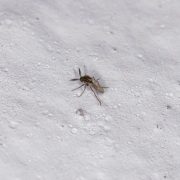Avoid Brittleness and Heavy, Unruly Hair with These Simple Tips
Posted on January 9, 2024 Written by: 100% PURE ®
While we love the ease of styling some good second or third-day hair, eventually all that product buildup is going to give way to greasy, weighed down locks. On the flip side, maybe your au naturel style has become dull, defiant, or simply doesn’t hold your trendy ‘dos any more. Sounds hair-rific, right?
If any of these are true, chances are that you’re due to clarify your strands. But to get to the root of unruly tresses, it’s important to look at your clarifying routine. Stay tuned for our best tips for clarifying hair, what you should avoid, and the best ways to get shiny, healthy hair.
If the sound of hair clarifying seems to give you a case of the hair scaries, don’t worry – it’s as simple as lather, rinse, repeat. But where or when clarifying comes into play depends on the amount of product build up, oil from our scalps, and dirt from the environment. Each of these will affect how our hair behaves. Instead of shiny hair that’s full of bounce and body you’ll end up with dull, lifeless locks.
Clarifying is like wiping the slate clean, and starting over with a squeaky-clean canvas on our scalp and strands. As a more amped up version of shampoo, clarifiers cut through product buildup, dirt, and oils to restore your hair’s shine, softness, and manageability. Even if you’re not someone who loads up on styling products or could rock five-day hair without the slightest oil doesn’t leave you exempt from hair clarifying – you just do it less.
Most people need to hit the reset button on their hair here and there to maintain super-clean locks. However, clarifying your hair too often can cause damage to your delicate strands.
If your hair type is oily, thick, and curly – or you swim a lot – limit your clarifying to once every 2-3 weeks.
If you have fine hair or lightly pigmented hair, you may find that monthly clarifying is more than enough for your hair type.
For dry hair types, you should be cautious in clarifying your hair. A dry scalp produces fewer natural oils to protect the hair shaft and create shine. Some harsh clarifying shampoos can worsen dryness by stripping what little oil is present. If you have dry hair, you should use a clarifying shampoo once every 6-8 weeks.
If you use several styling products that promote build-up like hairsprays, dry shampoos, and texturizers, you may need to use a clarifying shampoo more frequently. Ultimately, you should clarify as needed: your hair will let you know when it’s time!
We know you’re overjoyed to have shiny, voluminous locks, but selecting any old conventional clarifier could leave you with hair-raising results. Most traditional clarifying products are made with harsh, hair-dulling ingredients that could damage your hair or cause irritation for those with dry, sensitive scalps.
If you couple these hair culprits with all the heat styling and product overload we often do to our hair, you could be looking at damage and breakage. But don’t fret – we’ve got the all-important hair clarifying no-no’s to keep your locks luscious, bouncy, and healthy!
#1: Using sulfates
There are many hair products on the market that not only weigh your hair down, but leave you with dull and lifeless strands. One BIG hair culprit of these symptoms is sulfates. Though these harsh detergents create a sudsy feeling when you work up a lather, sulfates create a vicious cycle of aggressively stripped hair that then triggers your scalp to overproduce oil – the leading cause of greasy hair.
#2: Clarifying every day
Just to ‘clarify’ the tip earlier, using a clarifying shampoo too often can lead to more damage and breakage, especially for thicker, curlier hair as those hair types need constant moisture and lubrication to keep it bouncy and healthy. Overuse of clarifiers can also lead to dry, stiff, lackluster locks. Hair-no! You’ll want to find the best formula for your hair type and the frequency that suits it for a healthy mane.
#3: Using soft water and expecting clarified hair
Both hard water and soft water in your home can impact your hair. Soft water is good for hair prone to dryness, but it’s also one of most insidious underlying causes of buildup in the hair. Alternatively, too much exposure to hard water will become stripping for the hair.
Oily hair types or those trying to clarify hair should consider showerhead filters, or should cycle in a hard-water treatment every few weeks. Hard water or water with high mineral content can help break down stubborn residue that might be weighing your hair down.
#4: Not replenishing hydration and moisture after clarifying
If you choose to clarify your hair, deep conditioning afterward will be very important. If you don’t replenish with enough moisture, the scalp goes into oil production overload, undoing everything you’re trying to combat. Applying a leave-in conditioner or hair serum while the hair is damp or wet helps trap moisture in the strands for soft, hydrated locks.
#5: Brushing too hard or not using a moisture treatment
If you don’t replenish moisture or deep-treat hair after clarifying, your strands will be more prone to damage and breakage. Otherwise, simple styling like hair brushing or using hot hair tools can lead to serious hair woes. Our Pro-Vitamin B5 Smoothing Hair Serum specializes in serving smooth and shiny hair, and helps tame flyaways or repair stressed strands. It delivers essential vitamins and nutrients to thirsty, brittle tresses. The result is hair that grows stronger with each use!
Don’t leave your hair stranded. Now that we’ve covered the benefits of clarifying your hair, it’s time to find the top natural products that can gently clarify and balance your locks so you have can the healthiest, most luscious locks of your dreams.
Multi-Vitamin Healthy Hair Shampoo and Conditioner
Hair is primarily made up of a protein called keratin. Keratin is responsible for providing structure, strength, and elasticity to strands. Your hair’s elasticity determines its overall strength. If your locks are dry or brittle, or are prone to hair damage and breakage, you need keratin-infused products. Allow us:
This reparative shampoo and conditioner are fortified with beneficial multivitamins, like vegan keratin, biotin, pro-vitamin B5, and vitamin E, and they’re designed to replenish hydration, restore vibrancy, and leave your hair looking and feeling softer and healthier than ever. Plus, they’re safe for color or chemically-treated hair and can be used daily to keep your locks looking their best.
Best of all, these pH-balanced formulas are free of toxins commonly found in traditional hair care products, making them a great choice for anyone looking to prioritize their hair’s health and well-being.
Newsletter Subscribe
for more blog updates and exclusive discounts
Burdock and Neem Healthy Scalp Shampoo and Conditioner
Each follicle on your scalp is attached to an oil gland. Those with fine hair will have more hairs on their scalp than people with coarse hair, and will frequently find that their scalps get greasy quite quickly. If you have a dry scalp, itchy scalp, dandruff, or a combination of all, the best natural hair products should purify and unclog pores and balance strands, while also stimulating circulation to the scalp.
This purifying shampoo and conditioner dynamic duo gently clarifies hair, stimulates blood circulation to the scalp for new growth, and alleviates any scalp woes while adding hydration for a healthier scalp and hair. Key ingredients like burdock and neem will alleviate dryness, itching, and flaking, and will have you ‘back in black’ in no time!
For additional dryness relief, this formula includes vitamin E and pro-vitamin B5 to enhance hair softness and tensile strength. This sulfate-free natural shampoo is safe and gentle enough for color-treated hair. All in all, it’s a warrior for warding off excess oil and dandruff flakes once and for all.
It’s no secret that different hair types require different hair treatments, but all scalps benefit from some stimulation. And our favorite ingredient for promoting hair growth is rosemary oil. This essential oil is rich in antioxidants and anti-inflammatory properties that can help stimulate hair growth by improving blood circulation in the scalp, promoting nutrient delivery to hair follicles, and strengthening hair strands.
As most of us have come to discover, days-old hair can give way to product build up, oil from our scalps and dirt from the environment, which gets layered onto our hair and weighs it down. Instead of bouncy, luminous locks, it can end up looking dull, limp, lifeless and frizzy.
Hair clarifying is like pressing the reset button on our hair and scalp. It strips off any dirt, grease and creates the shine and volume you’ve come to love with fresh hair! Clarifying is key to keeping your crowning glory looking good and feeling strong, all while promoting healthy growth. With these tips, hopefully you can send weighed down, unruly hair to the sidelines – and happily take your hair game all the way to the finish line.
For more tips on hair clarifying, be sure to check out our post that also offers the best natural shampoo for shiny, healthy hair – and more!
What Are Common Misconceptions About the Frequency of Hair Clarifying?
Some common misconceptions about hair clarifying are that you should often clarify your hair. This is simply not true, and in fact, can be damaging in excess. Depending on your hair type, clarifying your strands shouldn’t exceed a few times a month. It’s also a misconception that a traditional hair clarifier will perform better than a natural alternative. Though both will get the job done, a natural hair clarifier will benefit your strands better, as these formulas don’t contain harsh chemicals that can adversely affect your hair and health.
How Can Over-Clarifying Affect Different Hair Types?
Absolutely! First off, constant hair washing and regular use of heat styling is a recipe for damaged and weakened locks. Then when combined with clarifying too often, it can lead to more damage and breakage, especially for thicker, curlier hair as those hair types need consistent lubrication to keep it healthy and soft. Dry hair types can also experience this damage, too.
What Are the Signs of Using the Wrong Clarifying Shampoo for Your Hair?
You may see flyaways and a lot of frizz. If you have curly hair, you may notice weighed down locks. You’ll also want to be careful if you have color-treated hair. That’s because heavy surfactants present in traditional hair clarifiers may damage your hair color. As a rule of thumb, if a clarifying shampoo doesn’t say it’s color-safe on the label, then it’s likely not suitable for color-treated hair. Opt for natural formulas, which don’t contain harsh ingredients that can harm your hair.
What Are Common Errors in Choosing Clarifying Products for Specific Scalp Conditions?
If you have problems such as psoriasis, dandruff, seborrheic dermatitis or other scalp conditions, you should be careful before using clarifying products. If you opt for a traditional clarifier for your scalp condition, it likely contains harsh chemicals that will exasperate the condition.
Chemical components such as surfactants in some clarifying products can dry out your scalp and cause cells to produce more oil. Therefore, if you’re dealing with an oily scalp, you can undesirably increase the problem of excessive oiliness in the hair.
Excessive use of clarifying products can cause hair breakage and scalp problems. With the deterioration of the balance of oils in the scalp, the hair becomes dry, frizzy, rough, uncontrollable and fragile. This can cause hair breakage and hair loss.
How Can Neglecting Post-Clarifying Care Affect Hair Health and Texture?
If you choose to clarify your hair, deep conditioning afterward will be very important. If you don’t replenish with enough moisture, the scalp goes into oil production overload, undoing everything you’re trying to combat. Plus, your strands are more prone to damage and breakage. Applying a leave-in conditioner or hair serum while the hair is damp or wet helps trap moisture in the strands for soft, hydrated locks.





